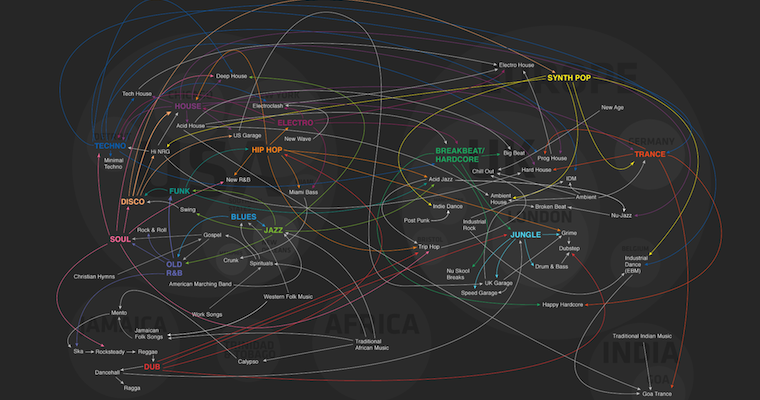With the rise of internet, communication between musicians in the far corners of the earth are suddenly at the tip of ones fingertips. Hell, I am writing this article from Baltimore, Maryland and know that it will be read by more eyes in Manchester, England than here in Baltimore. But discussing this global connectivity is nothing novel. Far better sociological writers than I have spent years analyzing the communicative powers of the internet and its global impact. So I am going to stick to that which I know and contend that the pace at which dance music now moves is ten times faster than it was twelve years ago and that this breakneck speed is thanks to the world wide web.
In my own personal study of dance music’s evolution, I came across a very interesting program that has been set up to highlight the progression of music since the early 1800′s entitled How Music Travels. Created by travel writer Osman Khan spent time tracing music through time and space from Africa and the Caribbean. With the help of secondary research development website Bass Culture, the excellent Last Night A DJ Saved My Life, and The All Music Guide to Electronica, along with Wikipedia and data market website Infochimp, Khan was able to figure out an accurate progression of Blues, Jazz, Funk, Disco etc to Synth Pop, Electro, techno and so fourth. The purpose of Khan’s study was to determine the birthplace of various dance music genres and subgenres and to create a comprehensible timeline and map so to allow a traveler to “follow the actual journey various music genres have taken as one style developed into another”.
To make it easier to trace the threads of music history, Khan created an interactive map detailing the evolution of western dance music over the last 100 years. The map shows the time and place where each of the music styles were born and which blend of genres influenced the next. Check out the finished product – an interactive map spanning both time and place – which maps both the time period and location where a specific genre emerged, as well as showing how and from where various genres were influenced.
Please note, however, that the map shows only the evolution of top level dance genres only, and does not delve into all possible sub-genres. As it is often difficult to pin-point the beginning of a genre to a single year, so Khan placed the birth of each genre within 5-year periods. Finally, Khan notes that when the explosion of dance music arrived in the 80s, many genres arrived in the same 5-year period as the genres they influenced. In this situation, the ‘influencer’ genre starts to fade in on the map at the time the influencing line appears. He also forewarns that non-dance music genres which influenced dance music are also included, but their own influences are not shown.
Perhaps most interestingly, Khan notes that often where a genre was first born was not the location it eventually gained most popularity. Click on the map below to be directed to Khan’s interactive map of the Evolution of Western Dance Music.
 Click image to open interactive version (via Thomson Holidays).
Click image to open interactive version (via Thomson Holidays).














